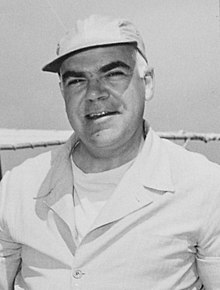Philleo Nash
Philleo Nash | |
|---|---|
 Nash in 1951 | |
| Commissioner of Indian Affairs | |
| In office September 20, 1961 – March 11, 1966 | |
| President | John F. Kennedy Lyndon B. Johnson |
| Preceded by | Glenn L. Emmons |
| Succeeded by | Robert L. Bennett |
| 33rdLieutenant Governor of Wisconsin | |
| In office January 5, 1959 – January 2, 1961 | |
| Governor | Gaylord Nelson |
| Preceded by | Warren P. Knowles |
| Succeeded by | Warren P. Knowles |
| Chair of theDemocratic Party of Wisconsin | |
| In office October 8, 1955 – October 12, 1957 | |
| Preceded by | Elliot Walstead |
| Succeeded by | Patrick Lucey |
| Personal details | |
| Born | October 25, 1909 Wisconsin Rapids, Wisconsin,U.S. |
| Died | October 12, 1987(aged 77) Marshfield, Wisconsin,U.S. |
| Resting place | Forest Hill Cemetery,Wisconsin Rapids, Wisconsin |
| Political party | Democratic |
| Spouse | |
| Children |
|
| Alma mater | University of Wisconsin University of Chicago(Ph.D.) |
| Profession | politician |
Philleo Nash(October 25, 1909 – October 12, 1987) was an American government official,anthropologist,and politician. A member of theDemocratic Party,he was Commissioner of theU.S. Bureau of Indian Affairs(1961–1966) during the presidencies ofJohn F. KennedyandLyndon B. Johnson.Previously, he was the33rdLieutenant Governor of Wisconsin(1959–1961) and was chairman of theDemocratic Party of Wisconsin(1955–1957).
Earlier in his career, he served more than 10 years as apolitical appointeein theFranklin D. RooseveltandHarry S. Trumanadministrations, including as Special Assistant directly to PresidentHarry S. Truman(1946–1952), influencing his policy ondesegregationof the armed forces and federal government, as well as policy related to Native Americans and other minorities.[1]
His wife,Edith Nash,was a poet and activist forhuman rightsandcivil rights.
Early life and family
[edit]Philleo Nash was born inWisconsin Rapids, Wisconsin.He grew up in theCongregational Church.He graduated from theUniversity of Wisconsinin 1932, and went on to graduate studies. In 1935, he received hisPh.D.inanthropologyfrom theUniversity of Chicago.
On November 2, 1935, he marriedEdith Rosenfelsof Oak Park, Illinois, whom he had met in graduate school in Chicago. She also trained in anthropology and did field studies in the American West in the 1930s. They had two daughters.
From 1937-1941, Nash was a Lecturer at theUniversity of Torontoand from 1941-1942, at theUniversity of Wisconsin.In this latter period, he also began to serve as a manager in his family's Biron Cranberry Company.
After they moved toWashington, D.C.,where he served in the government, Edith Nash became the second director of theGeorgetown Day School,the first racially integrated school in the capital. She was also an accomplished poet. Among other poetry books, she publishedPractice: The Here and Now(2001) by Cross+Roads Press. She founded the Riverwood Roundtable, a central Wisconsin literary society.[2]
Career
[edit]Philleo Nash gained political appointments to serve in the administrations ofFranklin D. RooseveltandHarry S. Truman(1946-1953). From 1942-1946, he served as Special Assistant to the Director, White House Liaison, Office of War Information.[1]During that wartime period, he worked on the issue ofconscientious objectorsduring the war, writing reports entitledSuggestions Concerning the Treatment of Conscientious Objectorsand theReport of the President's Amnesty Board.[1]
During the Truman administration, Nash served directly for the president as his Special Assistant from 1946-1952, and as his Administrative Assistant 1952-1953.[1]Nash worked on Truman's initiatives related to civil rights, including advising him of how to proceed with integration of the United States Armed Forces during a several-year period.[3]
As part of civil rights initiatives begun in 1946, in February 1948 Truman submitted a comprehensive civil rights bill to Congress; later that year, he issuedExecutive Order 9981to integrate the military. The same day, he issuedExecutive Order 9980to end racial discrimination in hiring in the federal government and initiate desegregation in the workplace (which PresidentWoodrow Wilsonhad segregated in 1914).[4]
From 1961–1966, Nash returned to Washington, D.C., from Wisconsin, where he was appointed as Commissioner of theUnited States Bureau of Indian Affairsduring the administrations ofJohn F. Kennedy,andLyndon B. Johnson.American Indians were increasingly active in demanding recognition of sovereignty and working for their civil rights.
Return to private life
[edit]In 1946 Nash became President of Biron Cranberry company, which he continued until 1977. After 1953 he retired the first time from public service and returned to Wisconsin, devoting his time to the family business. Philleo and Edith Nash had a cottage inBiron,where the company was located. They lived most of the time on Riverwood Lane inWisconsin Rapids.[5]
He returned to Washington, D.C., from 1961-1966, heading the Bureau of Indian Affairs, during a period when Native Americans were pressing for social justice. In 1963, he appeared onTo Tell the Truth,as himself, and spoke about the goals of the Bureau for improving the lives of Native Americans.[6]
Philleo Nash died inMarshfield, Wisconsin.
See also
[edit]Notes
[edit]- ^abcdTruman Papers:"Philleo Nash Files", Biographical Sketch,Truman Library
- ^[1],Poetry Dispatch blog
- ^"?".Archived fromthe originalon December 1, 2008.
- ^"Michael R. Gardner, Author and Attorney, 'Harry Truman and Civil Rights: Moral Courage and Political Risks'", 26 September 2003, UVA NewsMakers, University of Virginia TV News, accessed 13 March 2014
- ^"Nash, Philleo 1909".Dictionary of Wisconsin History.wisconsinhistory.org.
- ^"Charles Levier, Eleanor Cain, Philleo Nash".To Tell the Truth.28 October 1963.CBS.
References
[edit]- Philleo Nash papers,Truman Library
- Philleo Nash oral history,Truman Library
External links
[edit]- "Register to the Papers of Philleo Nash",National Anthropological Archives, Smithsonian Institution
- 1909 births
- 1987 deaths
- People from Wisconsin Rapids, Wisconsin
- Businesspeople from Wisconsin
- American Congregationalists
- Democratic Party of Wisconsin chairs
- Lieutenant governors of Wisconsin
- Franklin D. Roosevelt administration personnel
- Truman administration personnel
- Kennedy administration personnel
- Lyndon B. Johnson administration personnel
- Academic staff of the University of Toronto
- University of Wisconsin–Madison faculty
- University of Wisconsin–Madison alumni
- University of Chicago alumni
- United States Bureau of Indian Affairs personnel

